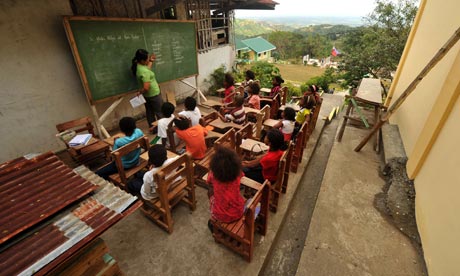The framework is composed of two parts:
I. The rectangular figures show the teaching-learning theoretical bases:
- beginning with the comprehensive Developmentally Appropriate Practices (DAP), then moving up to
- the principles and leading to
- the approaches.
II. The circle consists of three main components:
- Developmental Domains
- Learning Areas, and the
- Curricular Themes.
At the center is the Filipino child who is envisioned to be functionally literate and holistically developed.
A developmentally appropriate curriculum is one that is age-appropriate, individually appropriate and socio-culturally appropriate ( NAEYC, 2009)
This Kindergarten framework:
- considers the developmental benchmarks of Filipino five-year-olds,
- recommends the use of strategies that address needs and interests of the learners, and
- uses the mother tongue as medium of instruction.
Kindergarteners are constantly developing in the different domains (cognitive, language, physical, creative and aesthetic, socio-emotional, and values and character).
The National Early Learning Framework (NELF), formulated by the Early Childhood Care and Development Council, views the Filipino Child as the most important asset of the nation.
NELF furthers its view of the Filipino Child as…
…as a human being who loves God, parents, and country;
- is proud to be a Filipino;
- honors the customs , traditions and good values of the people,
- knows his/her basic rights;
- respects other cultures and
- is able to live in peace and harmony with all.
Thus beginning at an early age the child must be cared for and given all the opportunities to address current developmental needs and prepare him/her for lifelong learning.
Kindergarten classrooms, therefore, should be multi-level because kindergarteners will differ in their development in each domain.
The following are situations that a kindergarten teacher should put to mind.
1. every classroom is a multi-level classroom
2. every teacher is a multi-level facilitator
3. every learner is unique
4. everylearner has particular intelligence or intelligences
5. every learner has his/her own learning styles
6. every learner has his/her own particular needs
a. cognitive7. every learner has his/her own particular wants and interests
b. physical
c. socio-emotional
8. every learning has a right to develop uniquely from the others
"Naninindigan pa rin po tayo sa ipinangako nating pagbabago sa edukasyon: ang gawin itong sentral na estratehiya sa pamumuhunan sa pinakamahalaga nating yaman: ang mamamayang Pilipino. Sa K to 12, tiwala tayong mabibigyang-lakas si Juan dela Cruz upang mapaunlad—hindi lamang ang kanyang sarili at pamilya—kundi maging ang buong bansa." – Pangulong Benigno S. Aquino III
Every Filipino child now has access to early childhood education through Universal Kindergarten. At 5 years old, children start schooling and are given the means to slowly adjust to formal education.
Research shows that children who underwent Kindergarten have better completion rates than those who did not. Children who complete a standards-based Kindergarten program are better prepared, for primary education.
Education for children in the early years lays the foundation for lifelong learning and for the total development of a child. The early years of a human being, from 0 to 6 years, are the most critical period when the brain grows to at least 60-70 percent of adult size..[Ref: K to 12 Toolkit]
In Kindergarten, students learn the alphabet, numbers, shapes, and colors through games, songs, and dances, in their Mother Tongue.


No comments:
Post a Comment